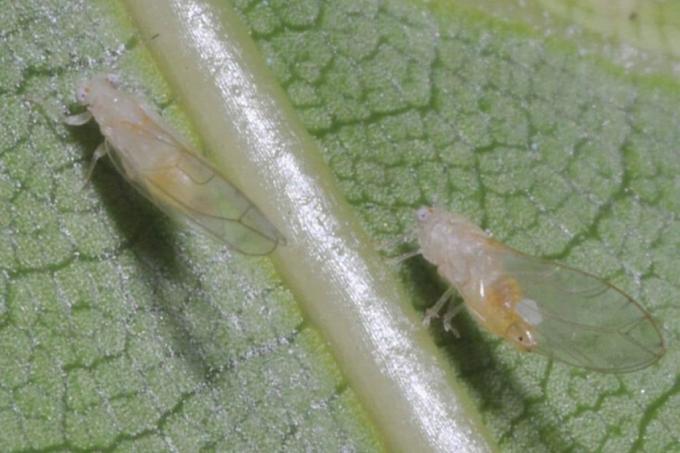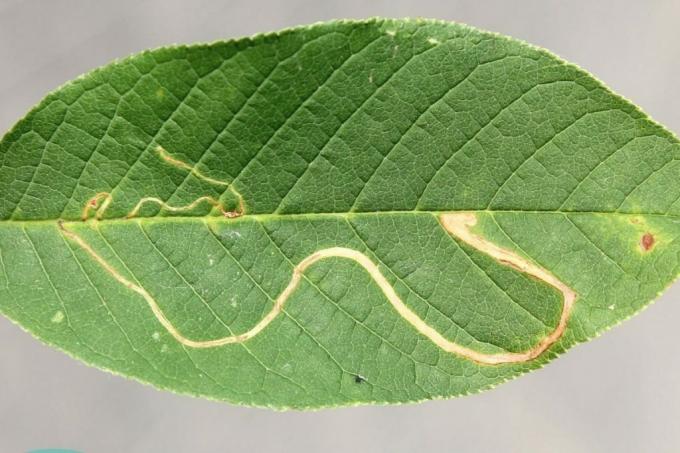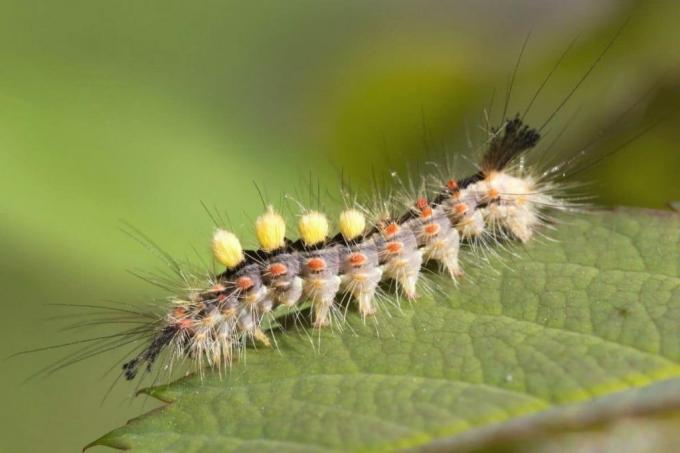
table of contents
- Leaf fleas (Psylloidea)
- Aphids (Aphidoidea)
- Black vine weevil (Otiorhynchus)
- Leaf miners (Gracillariidae)
- Blackthorn brush spinner (Orgyia antiqua)
- Scale insects (Coccoidea)
- frequently asked Questions
The cherry laurel is one of the most popular hedge plants. The evergreen plant with the creamy white flowers quickly forms dense hedges. However, cherry laurel is often attacked by pests. How can you recognize these and combat them effectively?
In a nutshell
- Cherry laurel susceptible to pests
- should be checked regularly for pest infestation
- the earlier pest control begins, the more sustainable the success
- Cherry laurel pests also attack neighboring plants
- Damage picture provides information about the cause and countermeasures to be taken
Leaf fleas (Psylloidea)
Leaf fleas are a subspecies of plant lice. Some species suckle the young shoots of the cherry laurel and feed on their sap. As with all plant lice, sticky excretions are part of the damage.
Recognize leaf fleas

- one to four millimeters in size
- can jump far
- strong body
- three point eyes
- Transparent wings and body
Damage image
- Deformities and discoloration of the leaves
- some species cause plant gall
- sticky coating on leaves
- Death of parts of the plant
- yellow-green larvae
Combat
- Remove shoots with visible infestation
- Spray the plant with soapy water
Aphids (Aphidoidea)
Aphids belong to the plant lice. They feed on the sap and are found on many types of plants. The cherry laurel bush can also be massively damaged by the small pest.
Recognize aphids

- one to four millimeters in size
- mostly wingless
- green, brown or black coloring
- feed on the sap
- excrete sweet, sticky honeydew
- multiply en masse
Damage image
- puckered, curled leaves
- yellow spots
- Settlement of sooty fungi
- numerous aphids on the underside of the leaves
Combat
- Spray the leaves of the cherry laurel with a strong jet of water.
- Water the shrub with it Nettle broth.
- Spray the leaves with soapy water.
- Repeat these processes if necessary.
Black vine weevil (Otiorhynchus)
The nocturnal black weevil is the most dangerous pest on the cherry laurel bush.
Recognize beetles

- ten to fourteen millimeters long
- black or brown coloring
- Back hairless and fluted
- strong trunk
- unable to fly
Note: Black vine weevils are nocturnal. They can only be observed in the evening hours.
Larvaerecognize
- yellowish-white with a brown head
- about ten millimeters long
- no legs
Damage image
- clear holes in the sheet margins
- Yellowing of the damaged leaves
Note: Not only the adult beetles, but also the larvae of the black weevil can damage the cherry laurel. They eat the roots, which affects the plant's water absorption. The inadequate supply leads to the death of the ornamental wood.
Combat
- Collect the bugs in the evening hours.
- Spread a white sheet under the bush. Shake the bush. The bugs fall down. Kill the bugs.
- Fill flower pots with wood wool. Place them upside down under the infested shrub. The beetles use the pots as shelter. Kill the bugs in the morning.
- Combat the larvae with nematodes. The roundworms penetrate the larvae and destroy them.
Leaf miners (Gracillariidae)
Occasionally leaf miners cause damage to the cherry laurel. The pests eat the leaves, impair photosynthesis and weaken the plant. A leaf miner infestation creates a clear picture of damage.
Recognize leaf miners
- one to four millimeters in size
- transparent wings
- black or brown spots on the upper body
Damage image

- yellow, later brown foliage
- Fall of the leaves
- Oviposition on the underside of the leaves
- after three weeks cocoons hang down from leaves
Combat
- Remove cocoons
- Destroy infested leaves in the residual waste or in the organic waste bin
Blackthorn brush spinner (Orgyia antiqua)
The caterpillars of the sloe brush moth feed on the leaves of various fruit and ornamental trees. If the cherry laurel is damaged, the voracious caterpillars can be behind it.
Recognize sloe brush spinners

- very hairy caterpillars with four tufts of brushes on their backs
- male moths brown, female moths gray
Damage image
- Eating spots on leaves and buds
Combat
- Picking up the caterpillars
Attention: The fine hairs of the brush spinner caterpillars can irritate the skin. Therefore put on gloves when collecting.
Scale insects (Coccoidea)
Scale insects are one of the most common pests on woody plants. You don't stop at the cherry laurel either. Just like aphids, they feed on the sap and prevent the plants from being supplied with nutrients.
Recognize scale insects

- two to six millimeters in size
- black
- Shield on the top
Damage image
- sticky coating on the leaves
- Settlement of sooty fungi
- Fall of the leaves
- Stunted growth
- black scale insects on the underside of the leaves
Combat
- Wipe off scale insects with a soft cloth or rag
- Spray the leaves and undersides of the leaves with neem oil or rapeseed oil
- Cherry laurel with Nettle broth to water
frequently asked Questions
The best way to prevent pest infestation is a natural garden. In places where birds, small animals and insects feel at home, weevils and co. Have no chance. Create shelter for beneficial insects, do without chemicals and give preference to native plants for your garden.
Plant parts that are sick or infected by pests do not belong on the compost. They can be safely disposed of in the residual waste or in the organic waste bin. In contrast to the compost heap, professional composting plants use organic waste at such high temperatures that the pests cannot survive.
Ladybugs and parasitic wasps can contain the infestation because they prefer to eat aphids, scale insects and aphids. Black weevils and brush moth caterpillars are on the menu of birds and hedgehogs. Bats help fight leaf miners.
Ants are not typical cherry laurel pests. However, they are attracted by honeydew, the sweet, sticky excretions of aphids, scale insects, and leaf fleas.
